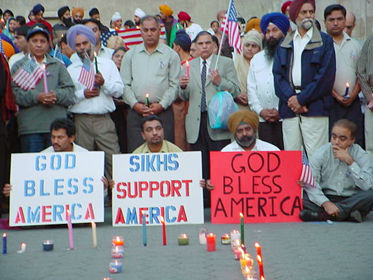
In the aftermath of the shootings by a white supremacist at a Sikh Temple in Wisconsin where six people were killed, I thought a greater understanding of the religion was needed. America has the fourth largest concentration of Sikhs in the world, behind Canada, U.K. and India, which has the largest population of this religious group.
President Obama and his wife were “deeply saddened” by the shooting, saying then that “the American people have them in our thoughts and prayers,” that the Obama administration will support an investigation of this incident and that “our country has been enriched by Sikhs, who are a part of our broader American family.”
All of those statements are great and are completely valid (even the last one) but what do they stop discrimination against this religious group? It seems Obama is not taking concrete action to stop other hate crimes against Sikhs even with the FBI calling this “domestic terrorism.”
As Rajdeep Singh, director of Law and Policy at the Sikh Coalition in Washington, D.C., noted on Democracy Now!, “The prevailing stereotype, which has been perpetuated by the media, is that if somebody wears a turban, they are associated with…extremism…the turban…signifies a commitment to upholding the traditions and principles of the Sikh religion.”
Singh notes that Sikhs are doing well in their professions, yet they face “existential challenges in the form of hate crimes and other forms of discrimination.” Singh’s last comment is something that should and must be heeded by the President and his administration: “…we hope that we can have a much needed dialogue in this country about religious pluralism, diversity, appreciation of diversity, and the need to not just accept each other but also appreciate each other.”
President Obama could use multiple pieces of legislation in the wake of this horrible massacre. The Civil Rights Act of 1968 allows government prosecution of someone who commits racial, religious or ethnic discrimination through intimidation, injury or force. The Violent Crime Control and Law Enforcement Act increased penalties for hate crimes and pushed states to use such statutes more forcefully. It is even possible that the assault weapons ban could be reinstated by the president.
Connected to this is calls by some, such as Colin Goddard, a student who lived through the shooting at Virginia Tech in 2007 who says that there should be stronger gun laws and that the American people are better than these acts of violence. The Justice Department might even use these two statutes to prosecute the suspected gunman who committed this act if religious hatred.
Even, so such proposals do not change the mindset of the people at large. As American humorist Will Rodgers noted, “You can’t legislate intelligence and common sense into people.” An approach that will change people’s approaches and push away stereotypes of Sikhs will be helpful.
Instead of people just focusing on the killer himself, the national conversation should begin to discuss diversity, religious pluralism, and accepting each other in America.
According to Sikh-Wiki, most of Sikhism’s holy texts promote nonviolence and love. Use of weapons is only allowed as a last resort and for self-defense or to defend someone weaker from an aggressor. Nowhere in the Sikh holy texts is violence and aggression promoted. In order to respect these Sikh values, one should know a bit about the history of this religion’s believers in America.
During the 19th century, Sikhism was the only religion from sub continental India to settle in the United States. The economic, political and life contributions that this religious group has made to American society is deep. There are those of a Sikh belief in the U.S. military and in the House of Representatives among other places. American people as a whole have been affected.
Since WWII, the number of Sikhs coming to the United States increased but it wasn’t until after 9/11 that discrimination against them began to increase dramatically. People accused them of being terrorists because they war turbans, causing them to be afraid because of this ugly stereotype. At the same time, some are assimilating into American culture.
This brief overview of Sikh beliefs and culture is meant to help readers gain a better understanding of this religion from the Indian subcontinent. Hopefully all Americans can use this article as a starting point to follow through on Singh’s words and start “…a much needed dialogue in this country about religious pluralism, diversity, appreciation of diversity, and the need to not just accept each other but also appreciate each other”
Photo: American Sikhs mourn the victims of 9/11 at a Sept. 15, 2001 vigil in Central Park, New York City. (CC)










